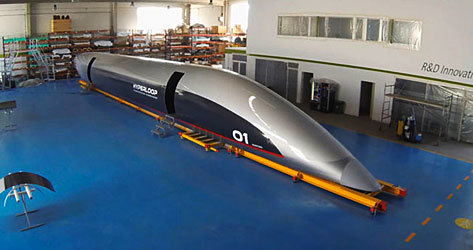- App.Two Spaniards create the formula to travel Europe for 50 euros
- Airlines.Bob or how to fly without carrying your suitcase
When in the 2001 film : Odyssey in Space (1968) by Stanley Kubrick we saw a space crew reading content on a portable screen, few could think that it would become a reality. Decades later, the iPad arrived. The same happened with the androids of the mythical Metropolis , the intelligent houses of Back to the future or the 3D printers of Star Trek.
However, we still lacked the supersonic trains of Blade Runner. The answer? The hyperloop , a high-speed transport thanks to the insertion of air tubes in the testing phase and that could forever change the way of managing public transport time.
Chronology of a supersonic train
As with other technologies, the origin of hyperloop is not recent. In fact, it is enough to go back to the end of the 19th century to discover Kingdom Brunel, a British engineer who already experimented with the manipulation of compressed air to transport cars at a higher speed.
An invention in which the American businessman Elon Musk (Tesla) rolled his eyes almost ten years ago, presenting in 2012 a first prototype of the hyperloop, a sister cousin of the train that allows to shorten distances at supersonic speed supported on an airbag propelled by induction motors and compressors.
An ally whom Musk came to describe as "a cross between a Concorde plane, a cannon and an air hockey table." That was how what began as an alleged exercise of arrogance, ended up becoming a reality.
In August 2013, a first theoretical route linking the city of Los Angeles with the bay of San Francisco (560 kilometers) in 35 minutes at a speed of 970 km / hour, began to attract the attention of investors and companies. Three years later, the first Hyperloop prototype was consolidated by Musk and its SpaceX brand through the US-based Virgin Hyperloop One concepts, or HyperloopTT, focused on China, where a test track has already been built. The first complete hyperloop test took place in Nevada in May 2017 at 112 kilometers / hour, 10% of the total speed to be achieved.
The future was here.
RENEWABLE ENERGY
From the expansion of the Hyperloop One brand and the worldwide deployment of a future transport revolution, many have been the predetermined routes that have begun to be tested, including one between the islands of Corsica and Sardinia ; another between Wales, Scotland and England ; or from Mexico City to Guadalajara, cities separated by 532 kilometers that would be traveled in just 38 minutes.
Routes that, even today, suffer from the doubts of engineers and investors due to the two main problems that hyperloops present: excessive costs and doubts in their safety, being the erosion of the tubes, the taking of curves or, especially, the nausea that passengers could suffer the main obstacles.
On the other hand, the creators insist on its many advantages: an efficiency superior to that of the airplane and the trains, or the reduction of carbon based on the use of renewable energies as a sustainable key of the transport of the future.
From Cádiz to Barcelona in an hour
The country that is closest to this reality is India, where a project that would link the cities of Mumbai and Pune with a stop at the Navi Mumbai International Airport in just thirty-five minutes is consolidated. A distance that takes two and a half hours by car and up to three by train.
The first phase of the project has been financed by the foreign company Dubai Port, which has disbursed 500 million dollars at the same time as the tests in Abu Dhabi, a city that would be linked to Dubai (140 kilometers) in just twelve minutes, progress Giant steps
This fever has also reached Spain, with the first route on the map being a route between Cádiz and Barcelona . Separated by more than 1,000 kilometers on a trip that reaches up to 11 hours by car, both cities would be united in just one hour of hyperloop. The first capsule, called Quintero One, 32 meters long and the work of the Carbures multinational Cadiz, is currently on trial.
As you can see, technology and innovation are advancing by giant steps, consolidating a hyperloop whose first official outline could see the light in the year 2030. Only then will we check what it feels like to travel at the speed of sound in the purest Minority Report style .
According to the criteria of The Trust Project
Know more- Barcelona
- Cádiz
- Return to the future
- Spain
- Elon musk
- Travels
- tourism
- Transportation and Tourism
ROUTE best of La Rioja according to four illustrious Riojans
The Walker: The Almeria-Seville flight manages to close the first half of the year with a passenger increase of 6.9 percent
El CaminanteEstepona opens two new sections of the Coastal Path in El Velerín with a journey of four coastal kilometers

